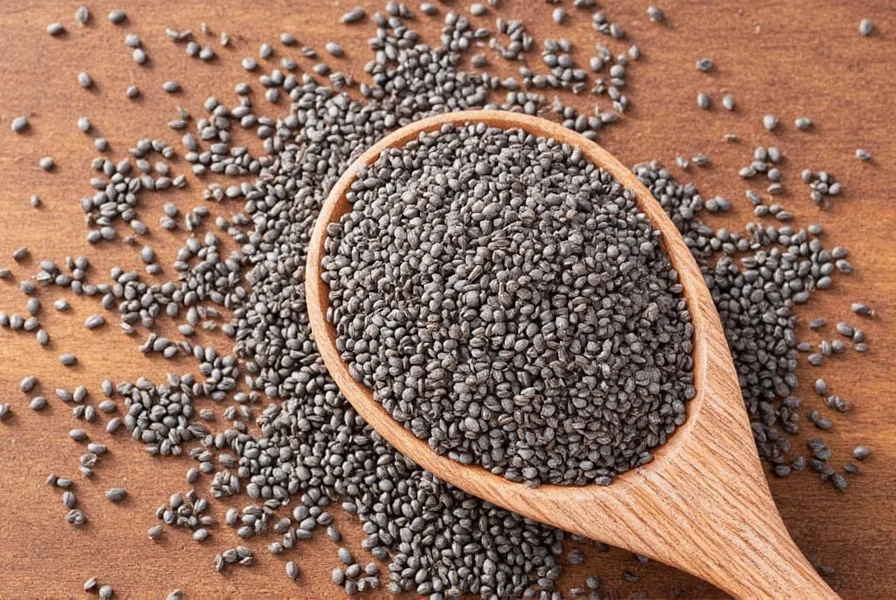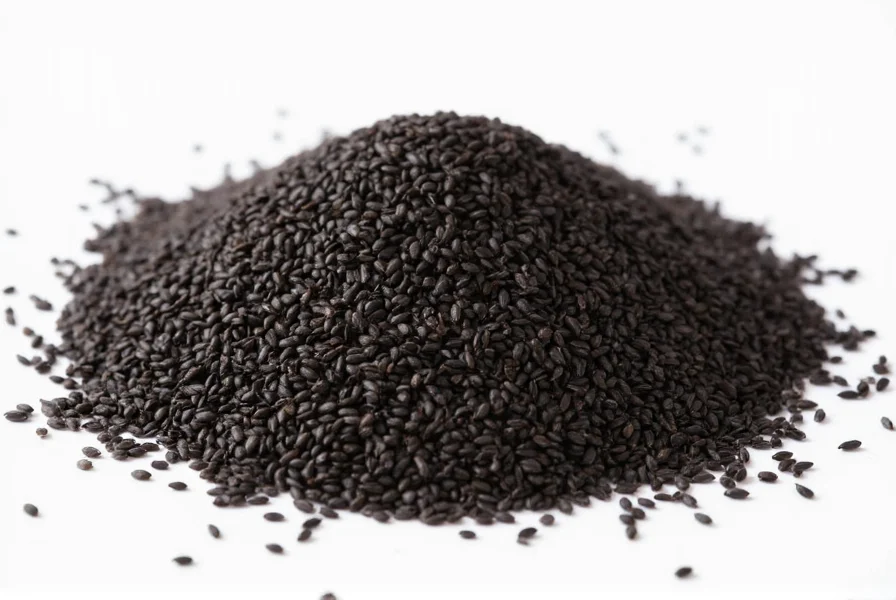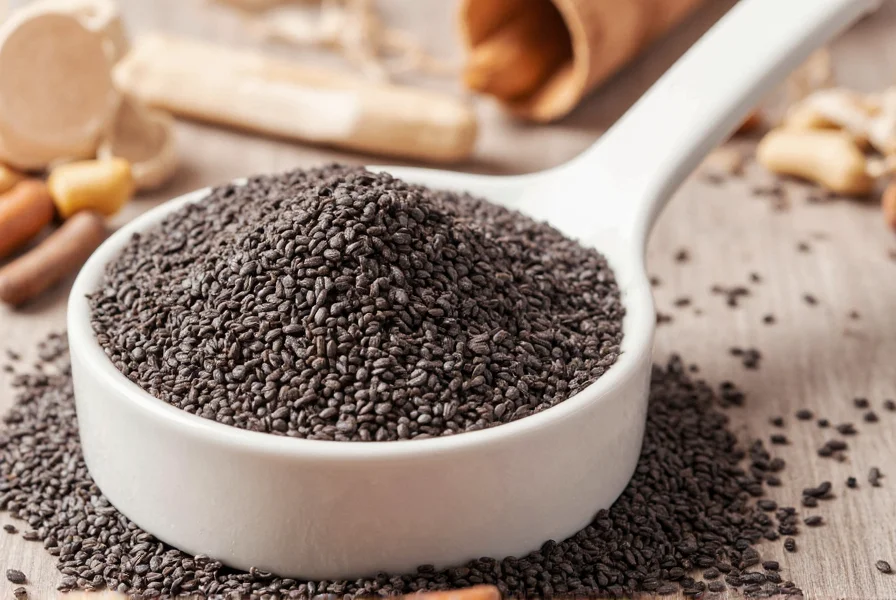Black sesame seeds offer significantly more nutritional value than white varieties due to their intact hulls, containing higher levels of antioxidants, calcium, and iron. These tiny black seeds deliver a richer, earthier flavor profile compared to white sesame seeds and work exceptionally well in both sweet and savory dishes when properly toasted. Here's everything you need to know about selecting, storing, and using black sesame seeds to maximize their culinary potential and health benefits.
What Are Black Sesame Seeds and Why They're Superior Nutritionally
Black sesame seeds (Sesamum indicum) are the unhulled variety of sesame seeds that retain their natural black pigment and protective outer layer. This hull retention is precisely why they contain 20-30% more calcium, double the iron, and significantly higher antioxidant levels compared to hulled white sesame seeds. The distinctive black color comes from anthocyanins - powerful antioxidants also found in blueberries and black rice.

Unlike white sesame seeds which have had their hulls removed through a process that strips away valuable nutrients, black sesame seeds maintain their complete nutritional profile. Traditional Chinese and Ayurvedic medicine have valued black sesame seeds for centuries for their ability to nourish blood, strengthen bones, and support healthy hair growth.
| Nutrient | Black Sesame (per 1oz) | White Sesame (per 1oz) | Difference |
|---|---|---|---|
| Calcium | 118mg | 98mg | +20% |
| Iron | 5.0mg | 2.6mg | +92% |
| Fiber | 4.0g | 3.3g | +21% |
| Antioxidants | Very High | Moderate | +100%+ |
Black Sesame vs White Sesame: Key Differences You Should Know
| Characteristic | Black Sesame Seeds | White Sesame Seeds |
|---|---|---|
| Hull Status | Intact hull | Hull removed |
| Flavor Profile | Earthy, robust, slightly bitter | Milder, sweeter, more neutral |
| Nutritional Value | Higher in calcium, iron, antioxidants | Lower nutrient density |
| Best Culinary Uses | Asian dishes, desserts, bold sauces | Lighter sauces, breads, general cooking |
| Storage Life | 6-8 months refrigerated | 4-6 months refrigerated |
How to Properly Toast Black Sesame Seeds for Maximum Flavor
The most common mistake home cooks make with black sesame seeds is improper toasting. Unlike white sesame seeds which toast quickly, black sesame seeds require more careful attention due to their darker color which makes it harder to judge doneness. Here's the professional method:
- Use a dry cast-iron or heavy-bottomed skillet (no oil needed)
- Spread seeds in a single thin layer
- Heat over medium-low (not medium) heat
- Stir constantly with a wooden spoon for 3-4 minutes
- Stop when you hear a gentle popping sound and smell a rich, nutty aroma
- Immediately transfer to a cool plate to prevent over-toasting

Over-toasted black sesame seeds become bitter and burnt-tasting. The ideal result should have a deep, roasted aroma without any blackened seeds. Properly toasted black sesame seeds will dramatically enhance both flavor and nutritional availability of their compounds.
Top 5 Health Benefits of Black Sesame Seeds Backed by Research
While all sesame seeds offer health benefits, black sesame seeds provide enhanced advantages due to their superior nutrient profile:
- Superior Antioxidant Protection: The anthocyanins in black sesame seeds provide significantly stronger antioxidant activity than white varieties, helping combat oxidative stress and inflammation throughout the body.
- Enhanced Bone Health: With approximately 12% of your daily calcium needs in just one tablespoon, black sesame seeds are an excellent plant-based source for maintaining bone density, particularly important for postmenopausal women.
- Improved Circulation: The high iron content (nearly 30% of daily value per ounce) supports healthy blood production and oxygen transport, making them valuable for those with anemia or fatigue.
- Heart-Healthy Fats: Rich in monounsaturated and polyunsaturated fats, black sesame seeds help maintain healthy cholesterol levels when consumed as part of a balanced diet.
- Beauty From Within: Traditional Asian beauty regimens have long used black sesame seeds for their ability to promote shiny hair, healthy skin, and strong nails thanks to their nutrient density.

How to Select and Store Black Sesame Seeds for Maximum Freshness
Quality varies dramatically among black sesame seed products. Follow these expert guidelines to ensure you're getting the best:
- Visual Inspection: Premium black sesame seeds should have a uniform jet-black color with no brown or gray seeds mixed in. High-quality seeds will appear plump and glossy.
- Smell Test: Fresh seeds should have a clean, nutty aroma. Avoid any with musty, rancid, or cardboard-like smells which indicate oxidation.
- Packaging Matters: Choose vacuum-sealed or nitrogen-flushed packaging which preserves freshness. Once opened, transfer to an airtight container and store in the refrigerator.
- Origin Considerations: Japanese and Korean black sesame seeds are generally considered superior in flavor and quality compared to Chinese or other varieties.
- Organic Certification: Given sesame's susceptibility to pesticides, organic certification is recommended for maximum health benefits.
| Brand | Quality Indicators | Best Uses | Storage Recommendation |
|---|---|---|---|
| Marukyu-Koyamaen (Japan) | Deep black, consistent size, strong nutty aroma | Black sesame paste, premium desserts | Refrigerate after opening - 8 months |
| Kadoya (Japan) | Vibrant color, minimal broken seeds | General cooking, garnishing | Refrigerate after opening - 6 months |
| JoyJas (Korea) | Rich aroma, medium-black color | Everyday cooking, baking | Refrigerate after opening - 6 months |
5 Professional Culinary Applications for Black Sesame Seeds
Move beyond basic sprinkling with these chef-recommended techniques:
- Black Sesame Salt (Gomashio): Combine 6 parts toasted black sesame seeds with 1 part sea salt in a mortar and pestle. The resulting condiment elevates rice, vegetables, and proteins with minimal effort.
- Sesame Oil Infusion: Gently heat neutral oil with black sesame seeds for 10-15 minutes (do not fry), then strain. This creates a flavorful oil perfect for dressings and finishing dishes.
- Black Sesame Cream: Blend soaked black sesame seeds with water (1:3 ratio) until smooth, then strain through cheesecloth. Use as a dairy-free cream base for soups, sauces, and desserts.
- Crust Application: Press whole or coarsely ground black sesame seeds onto proteins like salmon, chicken, or tofu before searing for a visually striking, flavorful crust.
- Dessert Incorporation: Add to cookie dough, cake batter, or ice cream base at the very end of mixing to maintain visual contrast and prevent color bleeding.
Frequently Asked Questions About Black Sesame Seeds
Are black sesame seeds healthier than white sesame seeds?
Yes, black sesame seeds are nutritionally superior to white varieties. The key difference is that black sesame seeds retain their hulls, which contain valuable fiber, antioxidants, and minerals. White sesame seeds have had their hulls removed, resulting in significantly lower calcium, iron, and antioxidant content.
How can I reduce the bitterness in black sesame seeds?
Proper toasting is the most effective method - toast over medium-low heat until fragrant but not darkened. Pairing with natural sweeteners like honey or maple syrup (in a 3:1 seed-to-sweetener ratio) balances bitterness while maintaining the distinctive flavor profile.
What's the best way to grind black sesame seeds for smooth paste?
Toast seeds first, then blend with 1-2 teaspoons of neutral oil per cup of seeds. For optimal results, use a high-speed blender in short bursts with cooling periods. Alternatively, traditional stone grinding produces superior texture and flavor release.
How long do black sesame seeds stay fresh after opening?
When stored in an airtight container in the refrigerator, properly stored black sesame seeds maintain peak freshness for 6-8 months. In the freezer, they can last up to 12 months. Always check for rancidity by smell before use - fresh seeds should have a clean, nutty aroma.
Can black sesame seeds help with hair growth?
Traditional medicine systems have long used black sesame seeds for hair health. While more research is needed, their high calcium, iron, and antioxidant content supports healthy hair follicles. Many users report improved hair texture and reduced hair loss when consuming 1-2 tablespoons daily as part of a balanced diet.

Why Black Sesame Seeds Deserve a Permanent Place in Your Pantry
While white sesame seeds have dominated Western pantries, black sesame seeds offer superior nutrition, more complex flavor, and greater culinary versatility. Their distinctive appearance adds visual interest to dishes while their robust flavor profile stands up to cooking better than more delicate white varieties.
By properly selecting, storing, and preparing black sesame seeds, you unlock their full potential as both a flavor enhancer and nutritional powerhouse. Whether you're looking to boost your mineral intake, add visual drama to your dishes, or simply expand your culinary repertoire, black sesame seeds deliver impressive results with minimal effort.

Ready to transform your cooking with the superior flavor and nutrition of black sesame seeds? Try one new technique from this guide in your next meal and experience the difference quality ingredients make.











 浙公网安备
33010002000092号
浙公网安备
33010002000092号 浙B2-20120091-4
浙B2-20120091-4